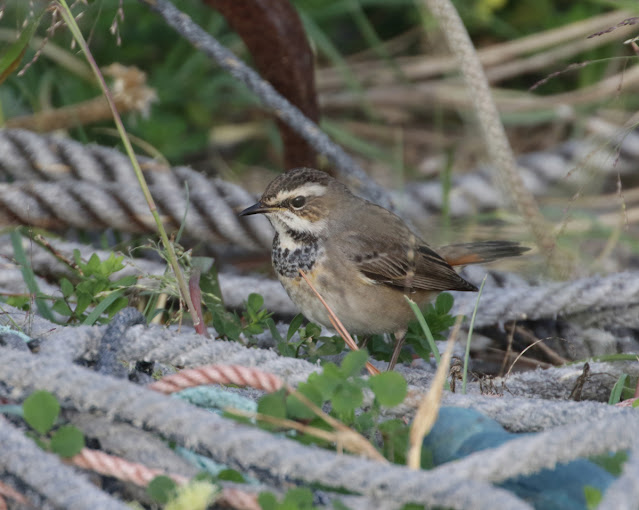It's possible to visit Hegura in October and find the place swamped with Kamchatka Leaf Warblers but not this time, there were surprisingly few considering the numbers of birds passing through. That said the selection of warblers, whether phylloscs or otherwise, was pretty good with eight (probably nine) species seen.
The 'probable' mentioned was a Middendorff's flushed from the track side and glimpsed diving into cover, everything about it fit the bill but I wasn't able to get a confirming view. Middendorff's is a species which can occur in good numbers on occasion... or so I suspect. There have been times over the years when I've seen several individuals in a single day which must translate into great many more of this skulker on the island.
Pallas's Grasshopper Warbler is even more of a skulker and, unlike Middendorff's, I've yet to see one sit up. I lucked into a very typical sighting on this trip, flushed from rank grass in a favourite cove of theirs. Stumbling through the tussock grass and overgrown rocks, trying to avoid sudden pools, this is where I've flushed all but one of my PG Tips on the island. This one flew a full 20 metres (a record?) before arrowing directly into cover. Normally they drop sooner into what might seem like less substantial cover but they're never to be seen again. This bird made directly for the type of cover their whole world population could have disappeared into. Why did I even bother to follow?
Black-browed Reed Warbler, on the other hand is an amateur skulker by comparison, I was able to see two birds quite well.
And that brings us to the phylloscs. The first day on the island the Kamchatkas were keeping close to or on the ground, yet despite my human sensibilities being unable to detect any significant change in weather they were up in the trees, but nevertheless still silent, by the third day.
 |
 |
I only had one Dusky Warbler during my stay (usually a few) though I know from other birders there were certainly more on the island. Perhaps, like the other phylloscs, they were less vocal than usual and therefore less obvious.
Returning to the minshyuku one evening I became aware of two small birds creeping through the sparse vegetation poking through the pebbles next to the path on the seaward side of the harbour-front houses. One of them flew across the path and down the side of a house. It was clearly either a Radde's or Dusky, fortunately the other bird stayed in the open giving itself up as the sole Radde's of the trip. It's likely the other bird would also have been Radde's but it'll have to go down as Radde's/Dusky.
 |
 |
 |
Sakhalin Leaf Warbler may never be as common as Kamchatka Leaf but the single bird I saw was also an unexpectedly low count, even if most will have already passed through. Strictly speaking I suppose this bird should be considered either Sakhalin or Pale-legged, who knows how many, if any, Pale-legged pass through Japan in Autumn; and which part of Japan if they do. I had three Pale-legged on Tsushima in spring this year and I've had a couple of spring birds on Mishima in the past too. Clearly they are scarce but regular in western Japan in spring, when singing birds are easily found.
This bird never called whereas in most years they call freely and are easy to locate but then the Kamchatka Leaf are also very vocal normally yet I didn't hear a single call this year; very strange. The weather really didn't seem as though it would keep birds quiet and the Yellow-brows were all as vocal as ever, half the birds I recorded were heard only. The bush warblers, thrushes, etc were also as vocal as ever. Inexplicable.
 |
 |
Oddly, considering how remarkably low phylosc numbers were in general, Yellow-browed weren't too far below par and I had four individuals on two of the days I spent on the island.
 |
 |
The big surprise was a Pallas's Leaf Warbler. I really don't think Pallas's Leaf is considered a rare migrant in Japan but I hardly ever see them. I honestly don't even remember the last one I saw and it's not as though they're inconspicuous, is it?
 |
 |












































